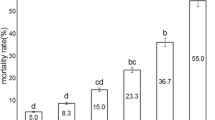Abstract
The retarded effect of continuous larval treatment withBacillus thuringiensis var.thuringiensis Berliner on the biological potency of adultAnagasta kuehniella (Zell) throughout successive generations was studied under controlled laboratory conditions. The results revealed a marked decrease in adult emergence and prolongation in the generation period that are directly proportional to concentration, but a negligible effect on the sex ratio. A significant reduction in the fecundity of the F1-moths was only observed with the highest concentration used.
Résumé
L'effet différé d'un traitement continu au stade larvaire avecB. thuringiensis var.thuringiensis Berliner sur le potentiel biotique de l'adulte deAnagasta kuehniella (Zell.) pendant des générations successives a été étudié au laboratoire.
Quatre concentrations de «Biospore 2802», allant de 7.104 à 7.105 spores viables par gramme d'aliment, ont été étudiées et comparées au témoin non traité. Les résultats font apparaître une réduction nette du nombre d'adultes et une prolongation de la durée d'une génération directement proportionnelles à la concentration, mais un effet négligeable sur le sex-ratio. Une diminution significative de la fécondité des papillons F1 n'a été observée que dans le lot traité à la plus forte concentration (1/5 000). La répétition du traitement à cette dose est nécessaire pour maintenir cet effet à un niveau constant chez la F2. De plus faibles concentrations produisent une réduction nette de la fécondité seulement si le traitement est répété pendant au moins 2 générations.
Similar content being viewed by others
References
Greenwood, E. S. — 1964.Bacillus thuringiensis in the control ofLucilia sericata andMusca domestica. —New Zealand J. Sci.,7, 221–226.
Jacobs, S. E. — 1951. Bacteriological control of the flour moth,Ephestia kühniella. —Proc. Soc. appl. Bacteriol.,13, 83–91.
Kantack, B. H. — 1959. Laboratory studies withBacillus thuringiensis Berliner and its possible use for the control of the Indian meal moth,Plodia interpunctella. —J. econ. Ent.,52, 1226–1227.
Shaikh, M. U. &Morrison, F. O. — 1966. Susceptibility of nine insect species to infection byBacillus thuringiensis var.Thuringiensis Berliner. —J. Invertebrate Pathol.,8, 347–350.
Veber, J. &Jasić, J. — 1961. Microsporidia as a factor in reducing the fecundity in insects. —J. Insect Pathol.,3, 103–112.
Yamvrias, C. — 1962. Contribution à l'étude du mode d'action deBacillus thuringiensis Berliner vis-à-vis de la teigne de la farineAnagasta kühniella. —Entomophaga,7, 101–159.
Author information
Authors and Affiliations
Rights and permissions
About this article
Cite this article
Afify, A.M., Matter, M.M. Retarded effect ofBacillus thuringiensis Berliner on the fecundity ofAnagasta kuehniella (Zell) . Entomophaga 14, 447–456 (1969). https://doi.org/10.1007/BF02390550
Issue Date:
DOI: https://doi.org/10.1007/BF02390550




